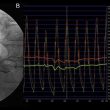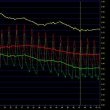Original Title: Image-based FFR during coronary catheterization. Presenter: Mariano Pellicano. Fractional flow reserve (FFR) is considered the gold standard to detect myocardial ischemia; however, due to its elevated cost, increased procedural time and potential complications associated to the guiding catheter, it is still underused. The FFRangio is a new technology based of angiographic images...
Could CT angiography replace coronary angiography in the short term?
Original Title: CT Angiography for the Prediction of Hemodynamic Significance in Intermediate and Severe Lesions. Head-to-Head Comparison with Quantitative Coronary Angiography Using Fractional Flow Reserve as the Reference Standard. Reference: Matthew J. Budoff et al. J Am Coll Cardiol Img. 2016;9(5):559-564. The aim of this study was to compare the diagnostic accuracy of non-invasive...
Is normal FFR always good prognosis?
Original Title: Coronary Flow Reserve and Microcirculatory Resistance in Patients with Intermediate Coronary Stenosis. Reference: Joo Myung Lee, el al. J Am Coll Cardiol 2016; 67:1158-69 Courtesy of Dr. Carlos Fava. Measuring fractional flow reserve (FFR) helps establish whether intermediate stenosis will generate ischemia, but it won’t help assess microcirculatory function. It has been shown that...
Impact of the Right Atrial Pressure on FFR measurement
Original Title: Impact of the Right Atrial Pressure on Fractional Flow Reserve Measurements Comparison of Fractional flow Reserve and Myocardial Fractional flow Reserve in 1600 Coronary Stenosis. Reference: Toth G, et al. JACC Cardiovasc Interv. 2016 Feb 12. Epub ahead of print. Courtesy of Dr. Guillermo Migliaro. Fractional Flow Reserve (FFR) is the gold standard for the...
FFR in non-ST elevation myocardial infarction
Original Title: Fractional flow reserve vs. angiography in guiding management to optimize outcomes in non-St segment elevation myocardial infarction: the British Heart Foundation FAMOUS–NSTEMI randomized trial. Reference: Jamie Layland et al. European Heart Journal (2015) 36, 100–111 Courtesy of Dr. José Amadeo Guillermo Álvarez. Several studies have established the value of fractional flow reserve (FFR) in...
Cutoff FFR Values, What to Do in the “Grey Zone”
Original Title: Significance of Intermediate Values of Fractional Flow Reserve in Patients with Coronary Artery Disease. Reference: Julien Adjedj et al. Circulation. 2016 Jan 5. Epub ahead of print. The fractional flow reserve (FFR) value of 0.75 has been validated against tests for inducible ischemia, whereas the value 0.80 has been widely accepted to guide the...
SCAI Releases Expert Consensus for Cardio-Oncology Patients Treated in Cardiac Catherization Labs
The Society for Cardiovascular Angiography and Interventions (SCAI) has released an expert consensus statement providing cardiologists, oncologists and internal medicine physicians guidance for treating patients facing concomitant cardiovascular disease and cancer. The document, “SCAI Expert Consensus Statement: Evaluation, Management, and Special Considerations of Cardio-Oncology Patients in the Cardiac Catherization Laboratory,” was released in Catheterization and Cardiovascular Interventions (CCI),...
FAME at 5 years: FFR Should Guide All Multivessel PCIs
Though the benefit of FFR (fractional flow reserve) over angiography is statistically important only over the first 2 years, this pattern is maintained at long term according to FAME 5 year follow up, presented at the ECS and simultaneously published in The Lancet. Between the second and fifth year, the number of patients at risk...
Estudo FFRCT RIPCORD: a FFR derivada da angiotomografia de coronárias pode mudar a estratégia terapêutica?
Fundamentos e objetivos: A reserva de fluxo fracionada (FFR) Invasiva é uma ferramenta bem validada e reprodutível para a detecção de lesão causadora de isquemia. Em pacientes com doença multiarterial uma estratégia PCI FFR-dirigida é associada a melhores resultados clínicos em comparação à PCI angiografia- dirigida. No estudo prévio RIPCORD, quando a FFR invasiva estava...
ILUMIEN I: Results of the angioplasty indicated by FFR and controlled by OCT
This is an observational, prospective, multicenter study using optical coherence tomography (OCT) and measurement of fractional flow reserve (FFR) before and after angioplasty. Inpatient following up was set at one month, six months, and one year. Before performing the OCT, the planned strategy was recorded and surgeons were free to change the strategy. The strategy...









